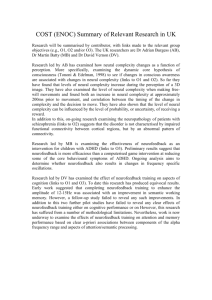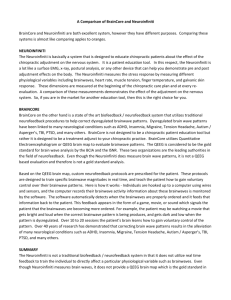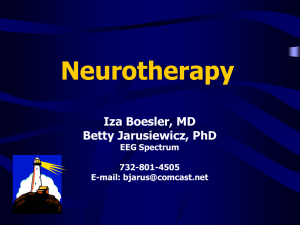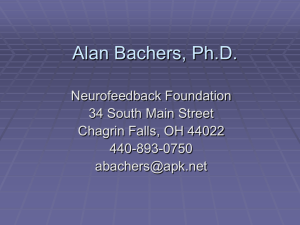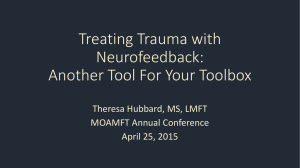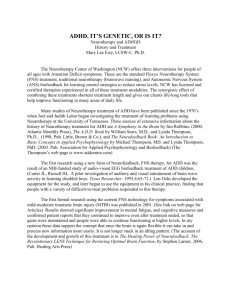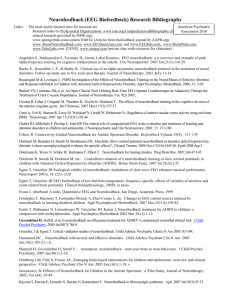What Is Neurofeedback? D. Corydon Hammond, Ph.D., ECNS, QEEG-D, BCIA-EEG
advertisement
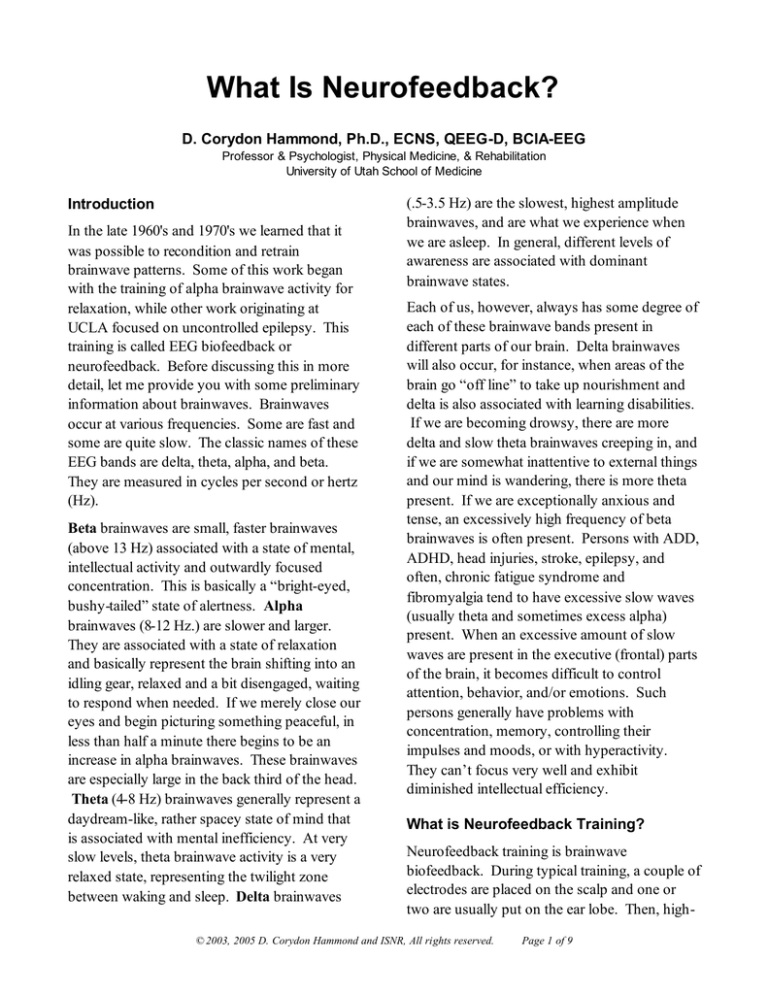
What Is Neurofeedback? D. Corydon Hammond, Ph.D., ECNS, QEEG-D, BCIA-EEG Professor & Psychologist, Physical Medicine, & Rehabilitation University of Utah School of Medicine Introduction In the late 1960's and 1970's we learned that it was possible to recondition and retrain brainwave patterns. Some of this work began with the training of alpha brainwave activity for relaxation, while other work originating at UCLA focused on uncontrolled epilepsy. This training is called EEG biofeedback or neurofeedback. Before discussing this in more detail, let me provide you with some preliminary information about brainwaves. Brainwaves occur at various frequencies. Some are fast and some are quite slow. The classic names of these EEG bands are delta, theta, alpha, and beta. They are measured in cycles per second or hertz (Hz). Beta brainwaves are small, faster brainwaves (above 13 Hz) associated with a state of mental, intellectual activity and outwardly focused concentration. This is basically a “bright-eyed, bushy-tailed” state of alertness. Alpha brainwaves (8-12 Hz.) are slower and larger. They are associated with a state of relaxation and basically represent the brain shifting into an idling gear, relaxed and a bit disengaged, waiting to respond when needed. If we merely close our eyes and begin picturing something peaceful, in less than half a minute there begins to be an increase in alpha brainwaves. These brainwaves are especially large in the back third of the head. Theta (4-8 Hz) brainwaves generally represent a daydream-like, rather spacey state of mind that is associated with mental inefficiency. At very slow levels, theta brainwave activity is a very relaxed state, representing the twilight zone between waking and sleep. Delta brainwaves (.5-3.5 Hz) are the slowest, highest amplitude brainwaves, and are what we experience when we are asleep. In general, different levels of awareness are associated with dominant brainwave states. Each of us, however, always has some degree of each of these brainwave bands present in different parts of our brain. Delta brainwaves will also occur, for instance, when areas of the brain go “off line” to take up nourishment and delta is also associated with learning disabilities. If we are becoming drowsy, there are more delta and slow theta brainwaves creeping in, and if we are somewhat inattentive to external things and our mind is wandering, there is more theta present. If we are exceptionally anxious and tense, an excessively high frequency of beta brainwaves is often present. Persons with ADD, ADHD, head injuries, stroke, epilepsy, and often, chronic fatigue syndrome and fibromyalgia tend to have excessive slow waves (usually theta and sometimes excess alpha) present. When an excessive amount of slow waves are present in the executive (frontal) parts of the brain, it becomes difficult to control attention, behavior, and/or emotions. Such persons generally have problems with concentration, memory, controlling their impulses and moods, or with hyperactivity. They can’t focus very well and exhibit diminished intellectual efficiency. What is Neurofeedback Training? Neurofeedback training is brainwave biofeedback. During typical training, a couple of electrodes are placed on the scalp and one or two are usually put on the ear lobe. Then, high- © 2003, 2005 D. Corydon Hammond and ISNR, All rights reserved. Page 1 of 9 tech electronic equipment provides you with real-time, instantaneous audio and visual feedback about your brainwave activity. The electrodes measure the electrical patterns coming from the brain--much like a physician listens to your heart from the surface of your skin. No electrical current is put into your brain. Your brainwave patterns are relayed to the computer and recorded. neurofeedback “should play a major therapeutic role in many difficult areas. In my opinion, if any medication had demonstrated such a wide spectrum of efficacy it would be universally accepted and widely used” (p. v). “It is a field to be taken seriously by all” (p. vii). Ordinarily, we cannot influence our brainwave patterns because we lack awareness of them. However, when you can see your brainwaves on a computer screen a few thousandths of a second after they occur, it gives you the ability to influence and change them. The mechanism of action is operant conditioning. We are literally reconditioning and retraining the brain. At first, the changes are short-lived, but the changes gradually become more enduring. With continuing feedback, coaching, and practice, we can usually retrain healthier brainwave patterns in most people. It is a little like exercising or doing physical therapy with the brain, enhancing cognitive flexibility and control. Thus whether the problem stems from ADD/ADHD, a learning disability, a stroke, head injury, deficits following neurosurgery, uncontrolled epilepsy, cognitive dysfunction associated with aging, depression, anxiety, obsessive-compulsive disorder, or other brain-related conditions, neurofeedback training offers additional opportunities for rehabilitation through directly retraining the brain. The exciting thing is that even when a problem is biological in nature, we now have another treatment alternative than just medication. Neurofeedback is also being used increasingly to facilitate peak performance in “normal” individuals and athletes. Some people wish that somehow they could simply buy their own neurofeedback equipment and train themselves or their children. Neurofeedback is not this simple. One needs to have specialized expertise concerning brain function and be knowledgeable about much more than simply how to operate equipment and software. For training to be successful and negative reactions avoided, it is vitally important for an assessment to be performed and that the training be individualized to the distinctive brainwave patterns and symptoms of each person. Everyone does not need the same training at the same locations and research has shown that a person’s brainwave patterns cannot simply be distinguished from only observing the person’s behavioral symptoms. Therefore, prior to doing neurofeedback training, legitimate clinicians will want to ask questions about the symptom history of the patient. In some cases they may do neuropsychological or psychological testing. Competent clinicians will also do a careful assessment and examine brainwave patterns. Some practitioners may do this by placing one or two electrodes on the scalp and measuring brainwave patterns in a limited number of areas. Other clinicians perform more comprehensive testing called a quantitative electroencephalogram (QEEG) or brain map where 19 or more electrodes are placed on the scalp. Frank H. Duffy, M.D., a Professor and Pediatric Neurologist at Harvard Medical School, stated in an editorial in the January 2000 issue of the journal Clinical Electroencephalography that scholarly literature now suggests that Assessment Prior to Neurofeedback Training A QEEG is an assessment tool to objectively and scientifically evaluate a person’s brainwave function. The procedure may take about 1½ © 2003, 2005 D. Corydon Hammond and ISNR, All rights reserved. Page 2 of 9 hours. It generally consists of placing a snug cap on the head which contains small electrodes to measure the electrical patterns coming from the brain. This is done while the patient is resting quietly with his or her eyes closed, and sometimes also with eyes open or during a task such as reading. Afterwards, we then go through a tedious procedure to remove any artifacts that occurred when the eyes moved or blinked, when patients moved slightly in the chair, or tightened their jaw or forehead a little bit. The brainwave data we gathered is then compared to a sophisticated normative database of how the brain should be functioning at the same age. Over a thousand statistical analyses are then performed. This assessment procedure allows us to then determine in a highly scientific, objective manner whether and how a patient’s brainwave patterns are significantly different from normal. neurofeedback (Hammond et al., 2004). Persons who are certified in this specialty may be identified either through the EEG & Clinical Neuroscience Society http://www.ecnsweb.com/cd_directory%620staters.html or the Quantitative Electroencephalography Certification Board (http://www.qeebboard.org/qeeglist.htm). Beginning during the 1970's and 1980's there began to be a great deal of experimentation with QEEG. The American Medical EEG Association Ad Hoc Committee on QEEG has stated that QEEG “is of clinical value now and developments suggest it will be of even greater use in the future.” QEEG has scientifically documented ability to aid in the evaluation of conditions such as mild traumatic brain injury, ADD/ADHD, learning disabilities, depression, obsessive-compulsive disorder, anxiety and panic disorder, and a variety of other conditions (including autism, schizophrenia, stroke, epilepsy, and dementia). QEEG has even been able to predict outcomes from treating conditions such as ADD/ADHD, alcoholism, and drug abuse. The American Psychological Association has also endorsed QEEG as being within the scope of practice of psychologists who are appropriately trained, and ISNR has similarly endorsed its use by legitimate health care professionals who are appropriately trained. Standards also exist for the use of QEEG in Neurofeedback Training The EEG and QEEG evaluations assist us in knowing if there are abnormalities in brain function that EEG neurofeedback might be helpful in treating, and it allows us to know how we can individualize neurofeedback to the unique problems of each patient. For example, scientific research has identified a minimum of three major subtypes of ADD/ADHD, none of which can be diagnosed from observing the person’s behavior, and each of which requires a different treatment protocol. Once the assessment is complete and treatment goals have been established, we usually place two electrodes on the scalp and one or more on the earlobes during neurotherapy training sessions. The trainee then watches a display on the computer screen and listens to audio tones, sometimes while doing a task such as reading. These training sessions are designed to teach the person to slowly change and retrain their brainwave pattern. With continuing feedback, coaching, and practice, the healthier brainwave patterns are maintained. Some persons may need to learn to increase the speed or size of brainwaves in some parts of the brain. Other individuals need training to decrease the speed of and amplitude of brainwaves in certain areas of the brain. Neurofeedback training may many times only require 15-20 sessions with anxiety or insomnia, but with other conditions such as ADD/ADHD or learning disabilities it will more often involve 40-50 sessions of about 40-45 minutes in length. In treating very complex © 2003, 2005 D. Corydon Hammond and ISNR, All rights reserved. Page 3 of 9 conditions or when multiple disorders or diagnoses are present, a clinician cannot always stipulate in advance how many treatment sessions may ideally be needed. ADD/ADHD & Learning Disabilities Since the late 1970's, neurofeedback has been researched, refined, and tested with ADD/ADHD and learning disabilities. Clinical work with Attention-Deficit/Hyperactivity Disorder and learning disorders by Dr. Lubar and his colleagues at the University of Tennessee and others has demonstrated that it is possible to retrain the brain. This neurofeedback research is quite strong in demonstrating its effectiveness in treating ADD/ADHD. Whereas the average stimulation medication study followup is only three weeks long and only two longterm follow-up medication studies that went 14 months or longer with ADD/ADHD, Dr. Lubar (1995) has published 10 year follow-ups on cases and found that in about 80% of patients neurofeedback can substantially improve the symptoms of ADD and ADHD, and these changes are maintained. Rossiter and LaVaque (1995) found that 20 sessions of neurofeedback produced comparable improvements in attention and concentration to taking Ritalin, and Fuchs et al. (2003) likewise demonstrated that neurofeedback produced comparable improvements to Ritalin, as did Rossiter (2005). In a one-year follow-up, control group study, Monastra et al. (2002) found that neurofeedback produced superior improvements to Ritalin, without needing to remain on drugs. Fernandez et al. (2003) demonstrated in a placebocontrolled study the effectiveness of neurofeedback with learning disabilities. Neurofeedback training for ADD/ADHD is commonly found to be associated with decreased impulsiveness/hyperactivity, increased mood stability, improved sleep patterns, increased attention span and concentration, improved academic performance, and increased retention and memory. Fascinatingly, every ADD/ADHD or learning disability study that has evaluated IQ pre- and post-treatment has found IQ increases following neurofeedback training. These improvements have ranged from an average of 9 IQ points improvement (Linden et al., 1996) in one study, to an average 12 IQ point improvement in another study (Thompson & Thompson, 1998), to a mean of 19 IQ points (Tansey, 1990), and even up to an average increase of 23 IQ points in still another study (Othmer, Othmer & Kaiser, 1999). Epilepsy, Brain Injuries & Stroke Uncontrolled epileptic seizures have also been effectively treated using neurofeedback. Research in this area began in the early 1970's, and is very extensive and rigorous, including blinded, placebo-controlled, crossover studies (reviewed in Sterman, 2000). Neurofeedback has been found to be helpful with all kinds of epilepsy, including grand mal, complex partial, and petit mal (absence) seizures. Although the larger proportion of seizure patients are adequately controlled by medication, most of the individuals who have been treated with neurofeedback in research studies are among the most severe epilepsy patients, where anticonvulsant drug therapy was unable to control their seizures. However, even in this most severe group of patients, research found that neurofeedback training on average produces a 70% reduction in seizures. In these severe cases of medically intractable epilepsy, neurofeedback has been able to facilitate greater control of seizures in 82% of patients, often reducing the level of medication required, which can be very positive given the long-term negative effects of some medications. Many patients, however, will need to remain on some level of medication following neurofeedback. Walker and Kozlowski (2005) reported on 10 consecutive cases and 90% were seizure free © 2003, 2005 D. Corydon Hammond and ISNR, All rights reserved. Page 4 of 9 after neurofeedback, although only 20% were able to cease taking medication. Treatment outcome studies of closed and open head brain injuries are also now beginning to be seen, as well as with stroke, but better research still needs to be done in these latter areas. We believe that neurofeedback offers a valuable additional option to assist in rehabilitation. Alcoholism & Drug Abuse EEG investigations of alcoholics (and the children of alcoholics) have documented that even after prolonged periods of abstinence, they have lower levels of alpha and theta waves and an excess of fast beta brainwaves in their EEG's. This means that alcoholics and the children of alcoholics tend to be hard-wired differently from other people, and this can make it difficult for them to relax. However, following the use of alcohol, the levels of alpha and theta brainwaves increase. Thus, individuals with a biological predisposition to develop alcoholism (and their children) are particularly vulnerable to the effects of alcohol. Without realizing it, alcoholics seem to be trying to self-medicate and treat their own brain pathology. The relaxing mental state that occurs following alcohol use is highly reinforcing to them because of the manner in which their brain is functioning. Several research studies now show that the best predictor of relapse is how excessive the beta brainwave activity is in both alcoholics and cocaine addicts (Bauer, 1993, 2001; Prichep et al., 1996; Winterer, 1998). Recently, EEG biofeedback training to teach alcoholics how to achieve stress reduction and profoundly relaxed states through increasing alpha and theta brainwaves and reducing fast beta brainwaves have demonstrated promising potential as an adjunct to alcoholism treatment. Peniston and Kulkosky (1989) used such training with chronic alcoholics compared to a nonalcoholic control group and a traditional alcoholism treatment control group. Alcoholics receiving 30 sessions of brainwave training demonstrated significant increases in percentages of their EEG record in alpha and theta rhythms, and increased alpha rhythm amplitudes. The brainwave treatment group also demonstrated sharp reductions in depression compared to controls. Alcoholics in standard (traditional) treatment showed a significant elevation in serum beta-endorphin levels (an index of stress and a stimulant of caloric [e.g., ethanol] intake), while those with brainwave training added to their treatment did not demonstrate an increase in beta-endorphin levels. On four-year follow-ups (Peniston & Kulkosky, 1990), only 20% of the traditionally treated group of alcoholics remained sober, compared with 80% of the experimental group who received neurofeedback training. Furthermore, the experimental group showed improvement in psychological adjustment on 13 scales of the Millon Clinical Multiaxial Inventory compared to traditionally treated alcoholics who improved on only two scales and became worse on one scale. On 16-PF personality inventory, the neurofeedback training group demonstrated improvement on 7 scales, compared to only one scale among the traditional treatment group. Thus neurofeedback training appears to hold encouraging promise as an adjunctive module in the treatment of alcoholism, and in remediating damage done through drug abuse. Posttraumatic Stress Disorder Peniston and Kulkosky (1991) added thirty 30minute sessions of alpha/theta EEG biofeedback training to the traditional VA hospital treatment provided to a group of PTSD Vietnam combat veterans, and compared them at 30 month follow-up with a contrast group who only received traditional treatment. On follow-up, all 14 traditional treatment patients had relapsed and been re-hospitalized, while only 3 of 15 neurofeedback training patients had relapsed. While all 14 patients treated with neurofeedback © 2003, 2005 D. Corydon Hammond and ISNR, All rights reserved. Page 5 of 9 had decreased their medication requirements by follow-up, among traditionally treated patients, only one patient decreased medication needs, two reported no change, and 10 required more psychiatric medications. On the Minnesota Multiphasic Personality Inventory, neurofeedback training patients improved significantly on all 10 clinical scales-dramatically on many of them--while there were no significant improvements on any scales in the traditional treatment group. Other Clinical Applications of Neurofeedback Training Neurofeedback has good research support for its effectiveness in treating anxiety (Moore, 2000). It is also being used to work with other clinical problems such as depression (Baehr, Rosenfeld & Baehr, 2001; Hammond, 2001), chronic fatigue syndrome (Hammond, 2001), fibromyalgia (Donaldson et al., 1998; Meuller et al., 2001), sleep disorders, Tourette’s, obsessive-compulsive disorder (Hammond, 2003, 2004), autism (Jarusiuwicz, 2002), Parkinson’s tremors (Thompson & Thompson, 2002), tinnitus (Gosepath et al., 2001; Schenk et al., 2005; Weiler et al., 2001), swallowing or gagging, incontinence and physical balance (Hammond, 2005), and essential tremor. Neurofeedback is being utilized in peak performance training, for instance in enhancing musical performance (Egner & Gruzelier, 2003), dance performance (Raymond et al., 2005), with athletes, business executives, for cognitive and memory enhancement in normal individuals (Hanslmayer et al., 2005; Rasey, Lubar, McIntyre, Zoffuto & Abbott, 1996; Vernon et al., 2003), and for “brain brightening” to counter effects of normal aging (Budzynski, 1996). However, these areas of application do not yet have strong research validation. Although there are many health care practitioners who are convinced of the effectiveness and value of this cutting-edge technology (and more than 2,000 clinicians are using neurofeedback), you should be aware that some insurance company personnel (whose job is to save their company money), and even some professionals (many of whom may not be aware of the latest published research), may regard all neurofeedback as experimental. Even in the case of well-validated biofeedback treatments, some insurance companies insist on defining all biofeedback as experimental and, thus, may not reimburse for these services. Adverse Effects, Home Training, & Selecting a Practitioner A mild side effect can sometimes occur during neurofeedback training. For example, occasionally someone may feel tired, spacey, and anxious, experience a headache, have difficulty falling asleep, or feel agitated or irritable. Many of these feelings pass within a short time after a training session. If you make your therapist aware of such feelings, they can alter training protocols and usually quickly eliminate such mild adverse effects. It is possible, however, for more significant negative effects to occur (Hammond et al., 2001) if training is not being supervised by a knowledgeable, certified (http://www.bcia.org/ ) professional where the training is individualized. A “one-size-fits-all” approach that is not tailored to the individual will undoubtedly pose a greater risk of either producing an adverse reaction or of simply being ineffective. There is heterogeneity in the brainwave activity within broad diagnostic categories (such as ADD/ADHD, head injuries, depression, autism, or obsessive-compulsive disorder) that requires individualization of treatment. Thus we emphasize once again that everyone does not need the same thing and that if training is not tailored to the person, the risk is greater of it being ineffective or very infrequently even © 2003, 2005 D. Corydon Hammond and ISNR, All rights reserved. Page 6 of 9 harmful. For instance, Lubar et al. (1981) published a reversal double blind controlled study with epilepsy which documented that problems with seizure disorder could be improved with neurofeedback, but they could also be made worse if the wrong kind of training was done. Similarly, Lubar and Shouse (1976, 1977) documented that ADD/ADHD symptoms could both improve, but also be worsened if inappropriate training was done. Therefore, seeking out a qualified and certified professional who will do thoughtful assessment of brain function (e.g., with a QEEG or careful assessment of the raw EEG activity) is deemed to be vitally important. If you are seeking help with a psychological, psychiatric, or medical problem like those discussed above, it is recommended that you determine that the practitioner you select is not only certified, but is also licensed for independent practice in your state as a mental health or health care professional. An increasing number of unqualified and unlicensed persons are managing to obtain neurofeedback equipment and seeking to basically practice psychology and medicine without a license. It is unfortunately becoming a “buyer beware” marketplace. In this regard, some individuals are now renting and leasing home training equipment. It is our strong recommendation that training with equipment at home should only be done under the regular consultation and supervision of a legitimately trained and certified professional, and preferably home training should only occur following closely supervised training that has occurred in the office for a period of time. We wish to caution the public that if this is not done that some negative effects (and a much higher probability of ineffective results) could occur from such unsupervised self-training. It is important to remember that the impressive success documented in research on neurofeedback is based on work with qualified professionals, following individualized assessment, and with training sessions that are supervised by a knowledgeable therapist rather than with unsupervised sessions taking place in an office or at home. Referral Sources You may identify certified practitioners who are doing neurofeedback training by consulting the website for the Biofeedback Certification Institute of America (www.bcia.org) and by examining the membership directory for the International Society for Neuronal Regulation (ISNR). Below you will find a few references to the literature cited above and a few web sites that provide further useful information. ISNR has listed on its web site a comprehensive bibliography of scientific outcome studies on neurofeedback that I have compiled and which is periodically updated. References Baehr, E., Rosenfeld, J. P., & Baehr, R. (2001). Clinical use of an alpha asymmetry neurofeedback protocol in the treatment of mood disorders: Follow-up study one to five years post therapy. Journal of Neurotherapy, 4(4), 11-18. Bauer, L. O. (1993). Motoric signs of CNS dysfunction associated with alcohol and cocaine withdrawal. Psychiatry Research, 47, 69-77. Bauer, L. O. (2001). Predicting relapse to alcohol and drug abuse via quantitative electroencephalography. Neuropsychopharmacology, 25(3), 332-240. Budzynski, T. H. (1996). Brain brightening: Can neurofeedback improve cognitive process? Biofeedback, 24(2), 14-17. Donaldson, C. C. S., Sella, G. E., & Mueller, H. H. (1998). Fibromyalgia: A retrospective study of 252 consecutive referrals. Canadian Journal of Clinical Medicine, 5(6), 116-127. © 2003, 2005 D. Corydon Hammond and ISNR, All rights reserved. Page 7 of 9 Egner, T., & Gruzelier, J. H. (2002). Ecological validity of neurofeedback: Modulation of slow wave EEG enhances musical performance. NeuroReport, 14(9), 1121-1224. Fernandez, T., Herrera, W., Harmony, T., Diaz-Comas, L., Santiago, E., Sanchez, L., Bosch, J., Fernandez-Bouzas, A., Otero, G., Ricardo-Garcell, J., Barraza, C., Aubert, E., Galan, L., & Valdes, P. (2003). EEG and behavioral changes following neurofeedback treatment in learning disabled children. Clinical Electroencephalography, 34(3), 145-150. Fuchs, T. Birbaumer, N., Lutzenberger, W., Gruzelier, J. H., & Kaiser, J. (2003). Neurofeedback Treatment for attention deficit/hyperactivity disorder in children: A comparison with methylphenidate. Applied Psychophysiology & Biofeedback, 28, 1-12. Hammond, D. C. (2001). Neurofeedback treatment of depression with the Roshi. Journal of Neurotherapy, 4(2), 45-56. Hammond, D. C. (2001). Treatment of chronic fatigue with neurofeedback and self-hypnosis. NeuroRehabilitation, 16, 295-300. Hammond, D. C., Stockdale, S., Hoffman, D., Ayers, M. E., & Nash, J. (2001). Adverse reactions and potential iatrogenic effects in neurofeedback training. Journal of Neurotherapy, 4(4), 57-69. Hammond, D. C. (2003). QEEG-guided neurofeedback in the treatment of obsessive compulsive disorder. Journal of Neurotherapy, 7(2), 25-52. Hammond, D. C. (2004). Treatment of the obsessional subtype of obsessive-compulsive disorder with neurofeedback. Biofeedback, 32, 9-12. Hammond, D. C. (2005, in press). Neurofeedback to improve physical balance, incontinence, and swallowing. Journal of Neurotherapy, Hammond, D. C., Walker, J., Hoffman, D., Lubar, J. F., Trudeau, D., Gurnee, R., & Horvat, J. (2004). Standards for the use of QEEG in neurofeedback: A position paper of the International Society for Neuronal Regulation. Journal of Neurotherapy, 8(1), 5-26. Hanslmayer, S., Sauseng, P., Doppelmayr, M., Schabus, M., & Klimesch, W. (2005). Increasing individual upper alpha by neurofeedback improves cognitive performance in human subjects. Applied Psychophysiology & Biofeedback, 30(1), 110. Jarusiewicz, B. (2002). Efficacy of neurofeedback for children in the autistic spectrum: A pilot study. Journal of Neurotherapy, 6(4), 39-49. Linden, M., Habib, T., & Radojevic, V. (1996). A controlled study of the effects of EEG biofeedback on cognition and behavior of children with attention deficit disorder and learning disabilities. Biofeedback and Self-Regulation, 21 (1), 35-49. Lubar, J. F. (1995). Neurofeedback for the management of attention-deficit/hyperactivity disorders. Chapter in M. S. Schwartz (Ed.), Biofeedback: A Practitioner's Guide. New York, Guilford, 493-522. Lubar, J. F., Shabsin, H. S., Natelson, S. E. et al. (1981). EEG operant conditioning in intractible epileptics. Archives of Neurology, 38, 700-704. Lubar, J. F. & Shouse, M. N. (1976). EEG and behavioral changes in a hyperactive child concurrent with training of the sensorimotor rhythm (SMR): A preliminary report. Biofeedback & Self-Regulation, 1(3), 293-306. Lubar, J. F., & Shouse, M. N. (1977). Use of biofeedback in the treatment of seizure disorders and hyperactivity. Advances in Clinical Child Psychology, 1, 204-251. Mueller, H. H., Donaldson, C. C. S., Nelson, D. V., & Layman, M. (2001). Treatment of fibromyalgia incorporating EEG-driven stimulation: A clinical outcomes study. Journal of Clinical Psychology, 57(7), 933-952. Monastra, V. J., Monastra, D. M., & George, S. (2002). The effects of stimulant therapy, EEG biofeedback, and parenting style on the primary symptoms of attention-deficit/hyperactivity disorder. Applied Psychophysiology & Biofeedback, 27(4), 231249. Moore, N. C. (2000). A review of EEG biofeedback treatment of anxiety disorders. Clinical Electroencephalography, 31(1), 1-6. Othmer, S., Othmer, S. F., & Kaiser, D. A. (1999). EEG biofeedback: Training for AD/HD and related disruptive behavior disorders. Chapter in J. A. Incorvaia, B. S. Mark-Goldstein, & D. Tessmer (Eds.), Understanding, Diagnosing, land Treating AD/HD in Children and Adolescents. New York: Jason Aronson, pp. 235-296. Peniston, E. G., & Kulkosky, P. J. (1989). Alpha-theta brainwave training and beta-endorphin levels in alcoholics. Alcohol: Clinical & Experimental Research, 13(2), 271-279. © 2003, 2005 D. Corydon Hammond and ISNR, All rights reserved. Page 8 of 9 Peniston, E. G., & Kulkosky, P. J. (1991). Alcoholic personality and alpha-theta brainwave training. Medical Psychotherapy, 2, 3755. Peniston, E. G., & Kulkosky, P. J. (1991). Alpha-theta brainwave neuro-feedback therapy for Vietnam veterans with combat-related post-traumatic stress disorder. Medical Psychotherapy, 4, 47-60. Prichep, L., Alper, K., Kowalik, S. C., & Rosenthal, M. S. (1996). Neurometric qEEG studies of crack cocaine dependence and treatment outcome. Journal of Addictive Diseases, 15(4), 39-53. Rasey, H. W., Lubar, J. E., McIntyre, A., Zoffuto, A. C., & Abbott, P. L. (1996). EEG biofeedback for the enhancement of attentional processing in normal college students. Journal of Neurotherapy, 1(3), 15-21. Rossiter, T. R. (2005). The effectiveness of neurofeedback and stimulant drugs in treating AD/HD: Part II. Replication. Applied Psychophysiology & Biofeedback, 29(4), 233-243. Rossiter, T. R., & La Vaque, T. J. (1995). A comparison of EEG biofeedback and psychostimulants in treating attention deficit/hyperactivity disorders. Journal of Neurotherapy, 1, 48-59. Schenk, S., Lamm, K., Gundel, H., & Ladwig, K. H. (2005). Effects of neurofeedback-based EEG alpha and EEG beta training in patients with chronically decompensated tinnitus. HNO (German), 53(1), 29-38. Sterman, M. B. (2000). Basic concepts and clinical findings in the treatment of seizure disorders with EEG operant conditioning. Clinical Electroencephalography, 31(1), 45-55. Tansey, M. A. (1990). Righting the rhythms of reason: EEG biofeedback training as a therapeutic modality in a clinical office setting. Medical Psychotherapy, 3, 57-68. Thompson, L., & Thompson, M. (1998). Neurofeedback combined with training in metacognitive strategies: Effectiveness in students with ADD. Applied Psychophysiology & Biofeedback, 23(4), 243-263. Thompson, M., & Thompson, L. (2002). Biofeedback for movement disorders (dystonia with Parkinson’s disease): Theory and preliminary results. Journal of Neurotherapy, 6(4), 51-70. Vernon, D., Egner, T., Cooper, N., Compton, T., Neilands, C., Sheri, A., & Gruzelier, J. (2003). The effect of training distinct neurofeedback protocols on aspects of cognitive performance. International Journal of Psychophysiology, 47, 75-85. Walker, J. E., & Kozlowski, G. P. (2005). Neurofeedback treatment of epilepsy. Child & Adolescent Psychiatric Clinics of North America, 14(1), 163-176. Weiler, E. W., Brill, K., Tachiki, K. H., & Schneider, D. (2001). Neurofeedback and quantitative electroencephalography. International Journal of Tinnitus, 8(2), 87-93. For more information about neurofeedback, I recommend the following web sites, which I have found to have good educational content. 1. The International Society for Neuronal Regulation: http://www.isnr.org/ 2. Association for Applied Psychophysiology & Biofeedback: http://www.aapb.org/ 3. Applied Neuroscience qEEG: http://www.appliedneuroscience.com/ © 2003, 2005 D. Corydon Hammond and ISNR, All rights reserved. Page 9 of 9

